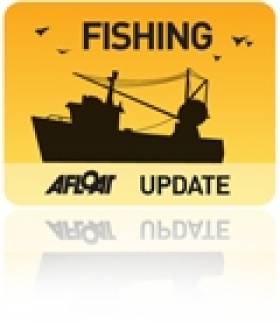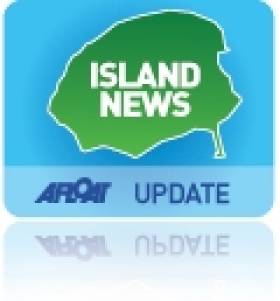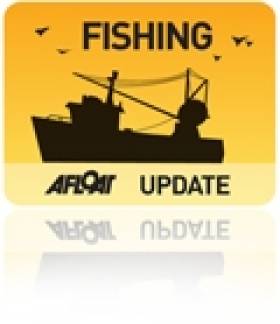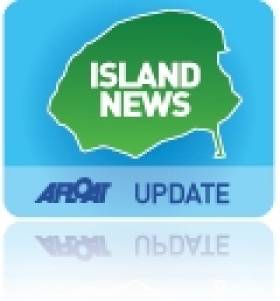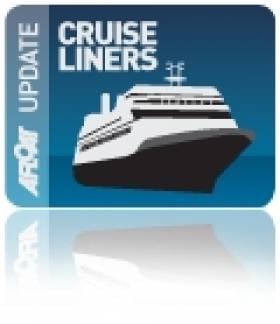Displaying items by tag: Aran Islands
#FISHING - Bord Iascaigh Mhara (BIM) has announced a "substantial delay" before it publishes the licence application for the controversial proposed deep-sea fish farm in the Aran Islands, as Galway Bay FM reports.
Though publication was originally planned for the beginning of this month, BIM says it will be another four to six weeks before it will be made available, following "meaningful and informative feedback" from the public during the most recent round of consultations on the project.
As previously reported on Afloat.ie, the 15,000-tonne organic salmon farm would be located off Inis Oírr on a 500-hectare site in Galway Bay, and would be one of the largest of its kind in Europe, projected to be worth €103 million annually for the economy.
Approval of the project could see the creation of as many as 400 jobs.
But the scheme has faced opposition from local anglers who fear that the fish farm could have a detrimental effect on wild salmon numbers.
Noel Carr, secretary of the Federation of Irish Salmon and Sea Trout Anglers (FISTA), described the fish farm plans as his group's 'Alamo'.
Busy Day for Aran Islands Capital
#ARAN ISLANDS CRUISE CALL – Two vessels, a cruiseship and a lighthouse tender are today off Kilronan, the capital of Inishmore, the largest of the Aran Islands, writes Jehan Ashmore.
The ships are the 114 passenger cruiseship Island Sky (1992/4,200grt) operated by Noble Caledonia which called this morning having originally departed in Portsmouth and the Commissioners of Irish Lights tender ILV Granuaile (2000/2,365grt) which is based in her homeport of Dun Laoghaire.
Kilronan will be a hive of activity, not just those passengers tendered ashore from the cruiseship but also tourists arriving by frequent ferry services from Rossaveal, Co. Galway and Doolin in Co. Clare. The majority of sightseers will no doubt be heading for the main attraction of Dun Aengus fort on the far side of the island which is reached by shuttle buses and the traditional pony and trap.
The Island Sky's sister the Caledonian Sky which too is operated by the same company made yesterday an anchorage call off Sneem Co. Kerry. It is along the western seaboard that such smallships are attracting a niche market. In addition it is in these same waters is where ILV Granuaile is more often to be found working during the summer months as the weather is more favourable to carry out aids to navigation duties.
Unlike the cruiseship, the lighthouse tender does not actually anchor. Instead she can maintain a constant position using dynamic positioning (DP) which uses satellite technology to adjust the vessels manouvering systems to precise pin-point accuracy.
#FISHING - Bord Iascaigh Mhára (BIM) has moved to allay fears that the proposed new fish farm in the Aran Islands would have a detrimental effect on wild salmon numbers, according to the Galway Independent.
BIM was reacting to concerns raised at a meeting of the Federation of Irish Salmon and Sea Trout Anglers (FISTA) held last Sunday, ahead of which the federation's secretary Noel Carr described the fish farm plans as its 'Alamo'.
As previously reported on Afloat.ie, BIM launched the consultation process last December for its proposed deep-sea salmon farm in Galway Bay on a 500-hectare site north of Inis Óirr.
Approval of the project, which would be one of the largest of its kind in Europe, could see the creation of 350 direct and 150 indirect jobs.
Among his group's concerns, Noel Carr told the Galway Independent that salmon farms such as that proposed for Galway bay were finding wild fish out in the North Atlantic and “hoovering it up to make fish meal”.
But Donal Maguire, aquaculture development manager for BIM, said that argument was "not true", adding that "the world catch for fishmeal has been sustainable for about the last 35 years".
The Galway Independent has more on the story HERE.
Red Bull Cliff Diving World Series Comes to Ireland
#ISLAND NEWS - Red Bull Cliff Diving will come to Ireland's west coast for the fourth stop of the 2012 World Series on 3-4 August.
The competition will see the world’s best cliff divers converge on the biggest of the three Aran Islands for the season’s halfway stage.
A ferry ride from Galway, Inis Mór is home to the Serpent’s Lair – ‘Poll na Peist’ in Irish – a natural formation that fishermen call a ‘blowhole’.
"What makes the Serpent’s Lair special," says Red Bull, "is that it’s a near-perfect rectangle, its inexplicable shape ensconced in Gaelic legend."
“The Serpent’s Lair is one of those places you only hear stories about,” said Colombian cliff diver Orlando Duque ahead of the first ever World Series in 2009. “Finding this place and being able to dive there was one of the highlights of my career."
Orlando’s hopes to return will surely be answered during the first weekend of August as he sets his sights on securing the 2012 title.
Other stops in this year's World Series include France on 22-23 June, Norway on 6-7 July, the Azores on 20-21 July, the USA on 24-25 August, the UK on 7-8 September and Oman on 27-28 September.
Aran Islands are 'the Stepping Stones to the Atlantic'
#ISLAND NEWS - Writing in the Boston Globe recently, Cork native Thomas Breathnach extols the virtues of the Aran Islands as "a bastion of native culture".
"The country’s roughest seas and 1,000 miles of ancient stone walls have successfully preserved Celtic tradition within their spellbinding shores," he writes of those western isles referred to as "the stepping stones to the Atlantic".
Traversing the archipelago by foot, bicycle and plane, Breathnach sees the sights and greets the characters that make the Aran Islands such an attraction for tourists the world over.
The Boston Globe has much more on the story HERE.
Licence Application for Aran Islands Fish Farm 'To Be Lodged in January'
#FISHING - The licence application for a proposed new deep-sea fish farm in the Aran Islands is expected to be lodged in January.
As previously reported on Afloat.ie, Bord Iascaigh Mhara's (BIM) planned 15,000-tonne organic salmon farm off Inis Oírr would be the largest of its kind in Europe, and would create hundreds of jobs in the area.
Commenting on the plans, Galway West Senator Fidelma Healy Eames said it was "a major opportunity for Galway and would represent a very significant economic boost for our coastal communities."
She added: "Deep sea fish farming has proven to be very economically beneficial in countries such as Norway, Chile and Scotland. It is timely that Ireland would capitalise on our fantastic marine resources as these countries have."
According to Healy Eames, the project is expected to "meet all environmental standards and will be barely visible from 2km away and effectively not visible from land.
"It would take up a negligible amount of inshore fisheries ground in the bay (0.22%) and would not interfere with existing fishing routes or Galway Bay ferry routes."
Europe's Largest Organic Fish Farm Proposed for Aran Islands
#FISHING - Bord Iascaigh Mhara (BIM) has begun the consultation process for a proposed new deep-sea fish farm in the Aran Islands, The Irish Times reports.
The 15,000-tonne organic salmon farm would be located off Inis Oírr on a 500-hectare site in Galway Bay, and would be one of the largest of its kind in Europe.
Approval of the project could see the creation of 350 direct and 150 indirect jobs, says BIM. It will be owned by the body on behalf of the State but leased to operators on a franchise basis.
The scheme has been welcomed by Comhar Caomhán Inis Oírr, but the island co-op said it was important that a promised €8-million pier for the island is constructed first to provide the necessary infrastructure.
The Irish Times has more on the story HERE.
Three’s A Crowd as Naval, Research and Cargo Ships Dock In Galway
Also sharing the basin but located closer to the dock gates was Arklow Shipping Ltd's Dutch registered dry-cargo vessel Arklow Surf (2000/2,316grt). The dock is capable of handling more vessels simultaneously and of course used as a host-port of the high-profile Volvo Ocean Race which is due to return next year.
Galway and neighbouring Limerick City with its Ted Russell Dock, are the only dock-gate accessed ports on the island of Ireland. In the case of Galway there is an exception as freight operations are also available from an outer pier on the seaward side of Dún Aengus Dock though only for domestic purposes. From this pier the dedicated Aran Islands freight service is operated by Lasta Mara TEO's Blath na Mara (1983/330grt). As for Limerick, vessels can also berth outside the dock but they tend to be small port-work related craft that use the outer berth on the Shannon Estuary.
The Galway Harbour Company in recent years have proposed plans for a new outer port, to be built in four stages with a completion date set for 2017. This would enable larger deeper drafted vessels such as tankers and cruiseships to dock in the new port. In the meantime cruiseships anchor off Mutton Island. In addition a freight rail-link, berthing for an inshore fishing fleet and a 216 berth marina are proposed.
To read more about the port proposals visit http://www.galwayharbour.com/news.php?id=11and for aerial visual impressions click HERE.
- River Shannon
- Marine Institute
- naval service
- Ports and Shipping
- Arklow Shipping Ltd
- Ports and Shipping News
- Aran Islands
- Island News
- Galway Bay News
- Marine Science News
- Dun Aengus Dock
- Galway Harbour Company
- Cruise Liner news
- Cruise ships
- Galway Harbour and Bay news
- Ted Russell Dock
- Marine Instistute Research vessels
- Lasta Mara TEO
Clipper Cruiseship Calls In for Fish & Chips
According to her schedule the Clipper Odyssey has since made several calls to include Waterford, Cobh and along the stunning scenery of the western seaboard with anchorage calls off the Great Blasket Islands, Dingle.
Yesterday the 5,218 tonnes vessel operated by Clipper Cruiuses had also called to Inishmore of the Aran Islands. Otherwise the 120 passenger cruiseship is normally found serving in the Pacific Ocean from New Zealand to the Russian Far-East. She is due to depart Co. Donegal this evening bound for Portrush.
As for the 226-passenger Le Diamant she is a frequent caller not just to Dublin, she had arrived from Penzance. The 8,282 tonnes vessel is run by Marseilles based Ponant Cruises and the twin-funnelled vessel is due to depart this evening for Fishguard.
Ferry Runs Aground off Doolin for Three Hours
According to ferry operator Kevin O'Brien, there were no passengers on board at the time and the vessel got under way again when it was lifted from the rocks with the tide. Mr O'Brien added "this was a very minor incident and there was no damage to the ferry. Doolin is tidal so these things do happen. Even a few inches of water can make a difference".
The Irish Coast Guard was notified of the incident at midday, and its marine rescue co-ordination centre in Dublin requested that members of the local Coast Guard unit board the vessel to assess if there was a pollution risk.
Doolin Coast Guard personnel carried out an inspection and confirmed the ferry had not been damaged and there was no risk of pollution. At about 2.15pm the ferry got under way again with the tide. The company was able to operate services to and from the Aran Islands with its second vessel.


























